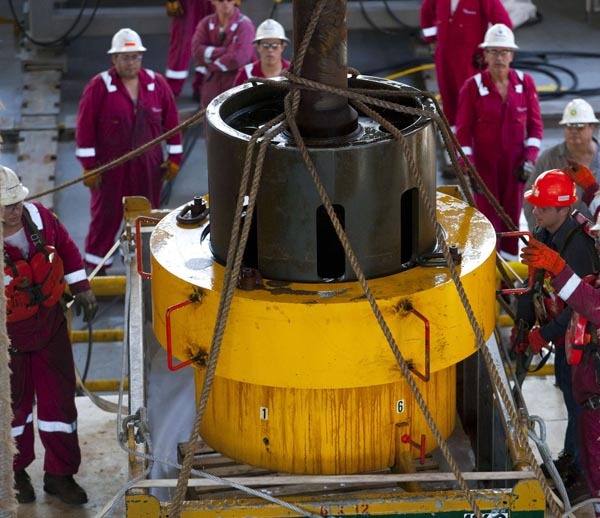BP confirms placing new cap over leaking well
BP confirmed Monday that it has placed a new containment cap on its underwater leaking well, in its first attempt to capture all the oil that is spewing into the Gulf of Mexico.
 |
|
Workers onboard the Transocean Discoverer Inspiration retrieve the flange overshot tool used to remove the flange from the Deepwater Horizon BOP, July 11, 2010 in the Gulf of Mexico. [Xinhua/Reuters Photo] |
The cap was installed on the blown-out well at 7 p.m. Monday local time (0000 GMT Tuesday), but tests are still needed to determine the effectiveness of the cap, the London-based company said in a press release.
The well integrity test will begin Tuesday and the process will last for a minimum of six hours and could extend up to 48 hours, it said.
Information gathered during the test will be reviewed with relevant U.S. government agencies including the federal science team to determine the way forward, BP said.
Options include reinstatement of containment as well as extending the test duration beyond 48 hours, it said.
During the test, BP said, all sub-sea containment systems, namely, the Q4000 and the newly hooked-up Helix Producer oil-recovery ship, will be temporarily suspended.
"It is expected, although cannot be assured, that no oil will be released to the ocean for the duration of the test," BP said.
The company removed the old cap on Saturday to make way for the installation of the new and larger one.
A third oil-recovery ship, the Helix Producer, had been expected to start up on Sunday but BP's chief operating officer Doug Suttles said two minor technical glitches prevented that.
BP said in its news release that the Helix Producer containment system has started operations. Suttles said the ship is expected to reach full capacity within two days or so.
With the new cap and the oil-capture vessels, the company expects all crude oil that has been spewing into the ocean at a rate of about 60,000 barrels a day should be contained.
However, Suttles said, even the cap works as planned, BP will continue to finish its two relief wells so that heavy drilling fluid and fluid can be pumped in to permanently kill the leak.
The first relief well, started May 2, reached a measured depth of 17,810 feet (one foot equal to 0.305 meters) on July 11, and the well is intended to intercept the original well at approximately 18,000 feet. The second relief well is below 16,000 feet, according to a BP statement issued earlier Monday.
On Monday, BP said the costs of cleaning up the Gulf oil spill has climbed to 3.5 billion U.S. dollars, including the costs of the spill response, containment, relief well drilling, grants to the Gulf states, claims paid and federal costs.
As of Saturday, it had received 105,000 claims and made more than 52,000 payments, totalling almost 165 million U.S. dollars.
 0
0 







Go to Forum >>0 Comments